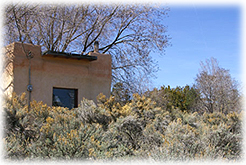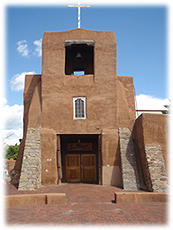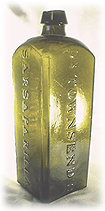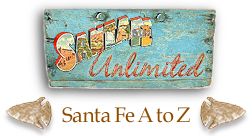|
|||
 Sagebrush SagebrushA coarse, aromatic, silvery-grey shrub with yellow flowers (of the daisy family), sagebrush grows in arid climates, and is common throughout New Mexico. Sagebrush has a strong pungent fragrance, especially when wet, which is not unlike common sage. It is, however, unrelated to common sage and has a bitter taste. It is thought that this odor serves to discourage browsing. (~Aimee) Salsa The word salsa is derived from the Latin word salsa (meaning salty) and sal (meaning salt). Salsa may refer to any type of sauce. In English it usually refers to the spicy, often tomato based hot sauces typical of Mexican cuisine; particularly those used as dips for corn tortilla chips. Most jarred, canned, and bottled salsa sauces sold in American grocery stores are forms of “salsa cruda/pico de gallo,” but to increase their shelf life, they have been cooked with vinegar added. These are not as authentic as freshly made salsas and typically have a semi-liquid texture more akin to that of canned tomatoes or chunky pasta sauces. There are fresh, all-natural jarred salsa products produced regionally that do not use artificial ingredients or chemicals to enhance shelf life. Fresh, refrigerated salsas, usually packaged in plastic containers, are also readily available, due to the enormous popularity of this appetizer/snack. (~Jean)  San Ildefonso Pueblo San Ildefonso PuebloLocated 22 miles north of Santa Fe off NM 502, the San Ildefonso Pueblo lies in a lovely country-like area between Nambe and Los Alamos. The ancestors of these people originally lived at Bandelier and Mesa Verde, Colorado, but due to a long-lasting drought, those earlier sites were abandoned. The identifying landmark of the area is the extraordinary Black Mesa, which can be seen for miles around. It was from the top of Black Mesa that the San Ildefonso people fought off Spanish soldiers in 1694. Today, San Ildefonso has preserved its cultural identity and still observes ancient traditions. The central plaza looks much the same as it has for several hundreds of years, with adobe homes surrounding it, though it now backs up to the non-pueblo, modern-day residential area of El Rancho. (~Jean) See more about the Eight Northern New Mexico Indian Pueblos San Juan Pueblo Located just two miles north of the town of Espanola, the San Juan Pueblo is the largest of the Tewa pueblos. Central plazas are bordered by a Catholic church, kivas and a chapel. Today, many of the original 700 homes, dating back before the pilgrims arrival at Plymouth Rock, are still standing adjacent to the Rio Grande river in the fertile Espanola Valley. The Pueblo owns the Ohkay Casino and a successful RV park and campground, which are open to travelers year-round. (~Jean) See more about the Eight Northern New Mexico Indian Pueblos  San Miguel Mission Church (The Oldest Church) San Miguel Mission Church (The Oldest Church)Recognized as “the Oldest Church in the United States,” San Miguel Mission is located one block south of Loretto Chapel on Old Santa Fe Trail, between Alameda and Paseo de Peralta. Within easy walking distance from the historic Santa Fe Plaza, it is now surrounded by lovely restaurants and shops, and with the “Oldest House” right down the alley, it’s definitely a must see on any Santa Fe site list. The Mission was built by Tlaxcalan Indians from Mexico in the early 1600s, under the direction of Fray Alonso de Benavides, OFM. During the Pueblo Indian rebellion of 1680, the roof was burned and destroyed. After resettling Santa Fe in 1694, General Diego de Vargas had a new roof constructed and repairs continued until 1710. A three-tier tower was constructed around 1830, and in 1887, a single facade tower was built, with massive stone buttresses added for support. The reredos (or altar screen) in the Mission dates from 1798, and is the oldest wooden reredos in New Mexico. There is also a wood carved statue of St. Michael, celebrating the victory over Satan. The Mission is open to the public during the week and there is a small gift shop adjoining the main church. Regular services are held each Sunday. (~Jean) See more about the Historic Churches of Santa Fe Santa Clara Pueblo Located off State Road 30, 26 miles north of Santa Fe, the Santa Clara Pueblo is in close proximity to the town of Espanola. Their ancestors originally lived in carved cave dwellings in the Puye Cliffs, but a period of drought forced their relocation to the fertile Espanola Valley, known as the primary farming area of Northern New Mexico. Today, a drive through the Santa Clara Pueblo clearly illustrates the adaptation of the New Mexico native peoples to modern-day living. The Pueblo’s 50,000-acre reservation is one of the largest of the Eight Northern New Mexico Pueblos. They own and operate the Big Rock Casino and Bowling Alley in the heart of Espanola, and the newly developed Black Mesa Golf Course. (~Jean) See more about the Eight Northern New Mexico Indian Pueblos  Sarsaparilla SarsaparillaDefinition: “A preparation of the dried rhizomes of various plants, especially smilax, used to flavor some drinks and medicines, and formerly as a tonic; a sweet drink flavored with this.” The primary uses of sarsaparilla are the flavoring of beverages and in folk medicine. As a medicinal product, sarsaparilla is supposedly a “blood purifier,” an aid to detoxing, and a general “pep agent” that is traditionally used in cordials and tonics to invigorate and cleanse the body. The sarsaparilla plant is mostly a vine, found primarily in Mexico, Central America and South America, although is has also been found up and down the East Coast of the United States. The most valued portion of the sarsaparilla is the root, which has been used for medicinal purposes for centuries, much like ginseng or licorice root. Natural sarsaparilla root is very bitter, so it was a common practice for pharmacists to distill the useful chemicals and mix them with sugar water. Thus, a popular beverage called sarsaparilla was born. It was enjoyed in its day, as Coca-Cola has been throughout the 20th century. The drink was actually called either sarsaparilla or “sasparilla,” and tasted much like today’s root beer. Other formulas substituted sarsaparilla root with a combination of birch oil and sassafras, a tree found in the western United States. Some believe the informal name of the drink, “sasparilla,” indicates the use of sassafras extract. Others say the name is simply a corruption of the original word, sarsaparilla. In the Old West, cowboys would drink sarsaparilla before making the rounds of the brothels. They thought it would ward off venereal disease. And Native Americans on the East Coast believed sarsaparilla was the supreme spring and blood tonic. A carbonated beverage called sarsaparilla is still manufactured today, but its taste is largely the result of artificial flavorings. Yet, bottled sarsaparilla can still be found in some old-time country stores and upscale grocery stores. (~Jean) Serape  A long blanket-like shawl, often brightly colored and fringed at the ends, worn especially by Mexican and Southwest Indian Men. (~Aimee) A long blanket-like shawl, often brightly colored and fringed at the ends, worn especially by Mexican and Southwest Indian Men. (~Aimee)Sopaipilla (or Sopapilla) A crisp, puffy, deep-fried pastry resembling an air-filled pillow. The sopaipilla is thought to have originated in Albuquerque, New Mexico, more than 200 years ago. It's a favorite Southwestern meal accompaniment, served with a honey bear for drizzling. Sopaipillas are also served as desserts, or sometimes filled with savory ingredients like refried beans. (~Aimee) Spanish Colonial Arts Society  In 1925, the Spanish Colonial Arts Society was founded in Santa Fe, New Mexico, by writer Mary Austin and artist-writer Frank G. Applegate. Its purpose was to preserve and perpetuate the Hispanic art forms that have been produced in New Mexico and southern Colorado since the region was colonized by Spain in 1598. Nearly a century later, its mission has been accomplished and expanded. Through the preservation and exhibition of its Spanish Colonial art collections at the Museum of Spanish Colonial Art, sponsorship of the annual Spanish Market exhibitions, and a range of outreach programs, the society is now a leader in the public education of traditional Spanish Colonial art and culture. In 1925, the Spanish Colonial Arts Society was founded in Santa Fe, New Mexico, by writer Mary Austin and artist-writer Frank G. Applegate. Its purpose was to preserve and perpetuate the Hispanic art forms that have been produced in New Mexico and southern Colorado since the region was colonized by Spain in 1598. Nearly a century later, its mission has been accomplished and expanded. Through the preservation and exhibition of its Spanish Colonial art collections at the Museum of Spanish Colonial Art, sponsorship of the annual Spanish Market exhibitions, and a range of outreach programs, the society is now a leader in the public education of traditional Spanish Colonial art and culture.The Spanish Colonial Arts Society collections were initiated in 1928. Today, with 3,000 objects, the collections are the most comprehensive compilation of Spanish Colonial art of their kind. Dating from the Middle Ages to the New Millennium, the collections span centuries in art, place and time. Among the various media featured are santos (painted and sculpted images of saints,) textiles, tinwork, silverwork, goldwork, ironwork, straw applique, ceramics, furniture, books, and more. A host of comparative objects from Spain and Latin America, as well as Asia, Bulgaria, France, and other worldly locales, further illustrate the faraway influences that converged during the colonial era to inspire artists and art forms. All combined, the collections represent the artistic history and ongoing evolution of Hispanic culture in New Mexico, while firmly establishing its important place within the global arts landscape. The Museum of Spanish Colonial Art is housed in a building that is part of the legacy of the acclaimed late architect John Gaw Meem. The building is a classic example of the Spanish Colonial or Pueblo Revival architectural style that Meem pioneered in New Mexico in the early 20th century. It also reflects Meem’s personal interest in the region’s Hispanic culture and his longtime involvement with the Spanish Colonial Arts Society. (~Jean) Pictured top to bottom: 1} Sagebrush surrounds a house outside of Santa Fe, New Mexico; 2} San Ildefonso Pueblo in Northern New Mexico; 3} The San Miguel Mission Church in Santa Fe, is the oldest church in America; 4} Vintage sarsaparilla bottle; 5} Delicious sopaipillas; 6} The Spanish Colonial Arts Society is housed in a Pueblo-Revival style building in Santa Fe, New Mexico |
|||
Home | Food | Lodging | Merchants | Services | Real Estate | Art & Galleries | Entertainment | Recreation Ski Areas | Mind-Body-Spirit | Santa Fe Information | Local Color | Canyon Road | The Turquoise Trail | Santa Fe Plaza The Pueblos | Scenic Beauty | Day Trips | Chili | Special Events | Santa Fe History | Multicultures | Museums High Road to Taos | The Wild West | Churches | Plants & Wildlife | Santa Fe Railyard | Turquoise | Architecture Fiesta | Indian Market | Spanish Market | Zozobra | Features | About Us | Get Listed! | Santa Fe Unlimited Trading Post Photo of the Week | Link of the Month | Testimonials | Santa Fe Webcams | Santa Fe Weather Santa Fe A to Z | Movie Locations | Santa Fe Unlimited Guestbook | Sitemap | Contact Us | Taos Unlimited All original graphics and content of this website, unless otherwise indicated, are copyright © 2006-2011 Santa Fe Unlimited and may not be reproduced in any fashion. |
|||

